Today we’re going to look at a portrait which is startlingly similar to last week’s Pelican Portrait, a portrait which almost looks like a mirror of the Pelican Portrait if you just glance at it quickly. Here it is, it is the Phoenix Portrait:-
The Phoenix Portrait was painted around the same time (perhaps a year later) as the Pelican Portrait and by the same artist, probably Nicholas Hilliard. Have a look at the portrait and see what symbols you can see, I’m struggling with this one!
Symbolism in The Phoenix Portrait
- The Phoenix – The portrait takes its name from the phoenix pendant which Elizabeth is wearing. The phoenix was used to symbolize sacrifice and rebirth, and the way that it rises from the ashes could speak of Elizabeth’s rise to power. The phoenix is also a symbol of Christ’s Resurrection and the promise of eternal life, and as only one phoenix lives at one time it may be a symbol of Elizabeth’s uniqueness. Another meaning of the phoenix is chastity, so it is another allusion to the Queen’s purity and virginity.
- Dress – Elizabeth is wearing a stunning costume, a French Gown decorated with pearls, embroidery and blackwork embroidery, as well as a spectacular ruff. It is a dress to impress and the black and gold colour speaks of Elizabeth’s wealth and status.
- Pearls – Again we have Elizbeth’s favourite jewellery and this time we have a strand around her waist, a girdle. Am I reading too much into this or could the positioning of those pearls, a symbol of purity and virginity, be speaking of her chastity?
- Red rose – The red rose is a symbol of love, beauty, secrecy, Christian martyrdom and the Virgin Mary, and the five petals of the rose were said to symbolize the five wounds of Christ. Could it be speaking of Elizabeth’s virginity and faith? I’m not sure.
- Ermine – I’m not sure whether the white furry bits at the bottom of the painting are a feathered fan or ermine. If it’s ermine then it’s another symbol of purity and also speaks of Elizabeth’s wealth and importance.
Does anyone have any idea if the leaf pattern on Elizabeth’s dress has any meaning? Can you see a symbol or message that I’ve missed? Let me know in the comments section below!
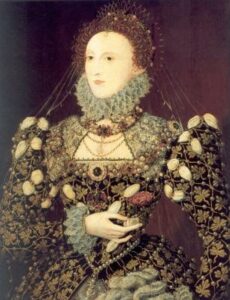
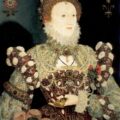
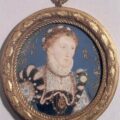
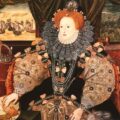
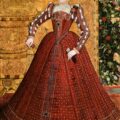
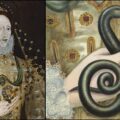


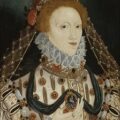
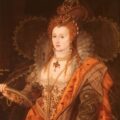
The only thing I can think of is Ireland- their symbol is a clover, like how England is the Tudor Rose, and Scotland is the thistle…I was trying to look for a thistle and tudor rose in this painting but couldn’t find them…perhaps I just cannot see them! =) Who was this painting painted for? Since she used them for propaganda, there is a possibility that she had this one sent to be hung in some house in Ireland…
I don’t remember another portrait of Elizabeth with a simple pearl girdle belt, offhand; it does seem unique. I like her ‘chain of office’ with the Tudor roses visible at center and at each shoulder. They’re a bit stylized, though; the center of each is an octagonal stone. I don’t know what the leaf embroidery is, but it’s lovely. This page:
http://www.elizabethancostume.net/gallery/qe-phoenix.html
says the gown is blue velvet, but it looks black in every version of it I could google. This kind of reminds me of that infamous Anne of Cleves portrait, in that the dress is extremely detailed but the face seems flat with few details, as though the artist just roughly sketched it in and then forgot to go back and finish it.
I think the object at the bottom of the portrait is a fan, they look like feathers curling over at the top, and most of the portraits with Ermine fur are decorated symetrically on both sides of her dress. (like the Clopton portrait) If it is a fan, it would represent conquest and expansion in the new world, as the feathers would be imported 🙂 There are a few other portaits with her holding these magnificent feather fans, might be worth a look 🙂 Hope this helps!
Could it be wine leaves? The pearls or beads on the dress would then be grapes. The two necklaces (the one holding the phoenix pendant and the shorter one of the same kind) look like they are stuffed with bunches of grapes. Wine would of course symbolize the Holy Communion, which would go very well with the phoenix…
Hi! First of all, I think this is an awesome site and a great resource–I for one really appreciate it.
I think you have some very good analysis here. Fun fact: I think this was the model for one of Elizabeth’s dresses in “Elizabeth R.” A couple of comments…
Pearls: I don’t think you’re reading too much into it. Elizabeth was a PR genius, and nothing was an accident. I’m almost certain the pearls were meant to symbolize her virginity.
Red Rose: It could have symbolized all the things you mentioned, but more obviously the rose is the symbol of the House of Tudor. Although that doesn’t really look like a typical Tudor Rose. It also could be a callback to the famous Anne Boleyn portrait at Hever–if you look at the way she’s holding the rose, it’s very similar. I like the idea of Elizabeth continuing to find subtle ways to honor her mother, but women holding roses in portraits wasn’t exactly uncommon in that time. So I’m going to withhold judgement on that.
Leaf pattern…well, sometimes a leaf is just a leaf. But I just finished saying nothing in Elizabethan propaganda was an accident, so I’ll roll with it: the leaves could serve to portray Elizabeth as some sort of woodland fairy goddess, i.e. the thinly veiled Elizabeth references in A Midsummer Night’s Dream.
If you look at the dress the “leaves” that are embroidered arent actually leaves but a phoenix or a bird. If you tilt the picture around you can see that there is a head, a beak, a neck and the base of the bird with feathers. It was called the phoenix portrait due to that emblem, and represented Elizabeth as person that beat all odds and “rose from the ashes” as the new celebrated monarch of England.
Thanks, Chris, I thought that they were just leaves but you’re right – well done!
i have to look at this portrait for history homework, and personally, i think that the leaves mean that she is growing (like a leaf) and at the end of that cycle she will have experienced a lot and will be a lot stronger. i might be wrong, but that’s what i think.
As well as the phoenix patterns on the dress symbolising sacrifice and rebirth, there are cherries on the pattern of the dress, which I think could represent sweetness.